Literature Review: Impact of NAPLAN Tests on Secondary School Teachers
VerifiedAdded on 2023/01/13
|7
|1507
|46
Literature Review
AI Summary
This literature review analyzes an article examining the views of secondary school English teachers in New South Wales, Australia, on the NAPLAN standardized test. The article explores teachers' opinions on the test's validity, its impact on student stress and anxiety, and its ability to accurately measure student intellect. The methodology involved a survey of 700 teachers, combining quantitative and qualitative data to understand their perceptions. The research question centers on teachers' views on NAPLAN, aiming to add to existing literature on the social and political aspects of school mechanics. The results indicate strong teacher antipathy toward NAPLAN's ability to accurately assess literacy skills, with many teachers believing they are better judges of their students' abilities. The review highlights concerns about the test's influence on curriculum content and its limited ability to prepare students for future employment. The conclusion aligns with other studies, emphasizing the negative consequences of the test and the importance of recognizing individual factors. The review also references several scholarly articles on the topic.
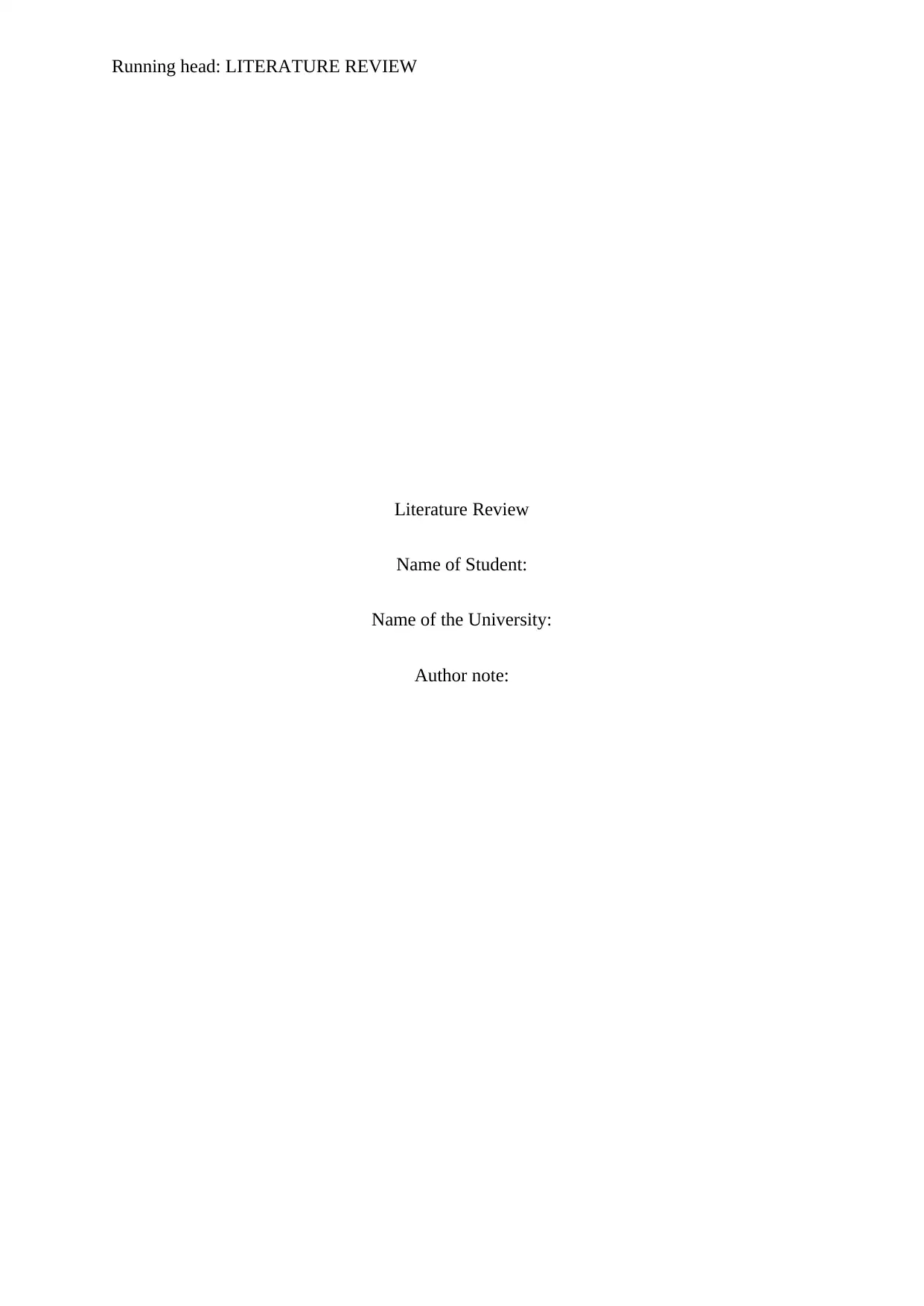
Running head: LITERATURE REVIEW
Literature Review
Name of Student:
Name of the University:
Author note:
Literature Review
Name of Student:
Name of the University:
Author note:
Paraphrase This Document
Need a fresh take? Get an instant paraphrase of this document with our AI Paraphraser
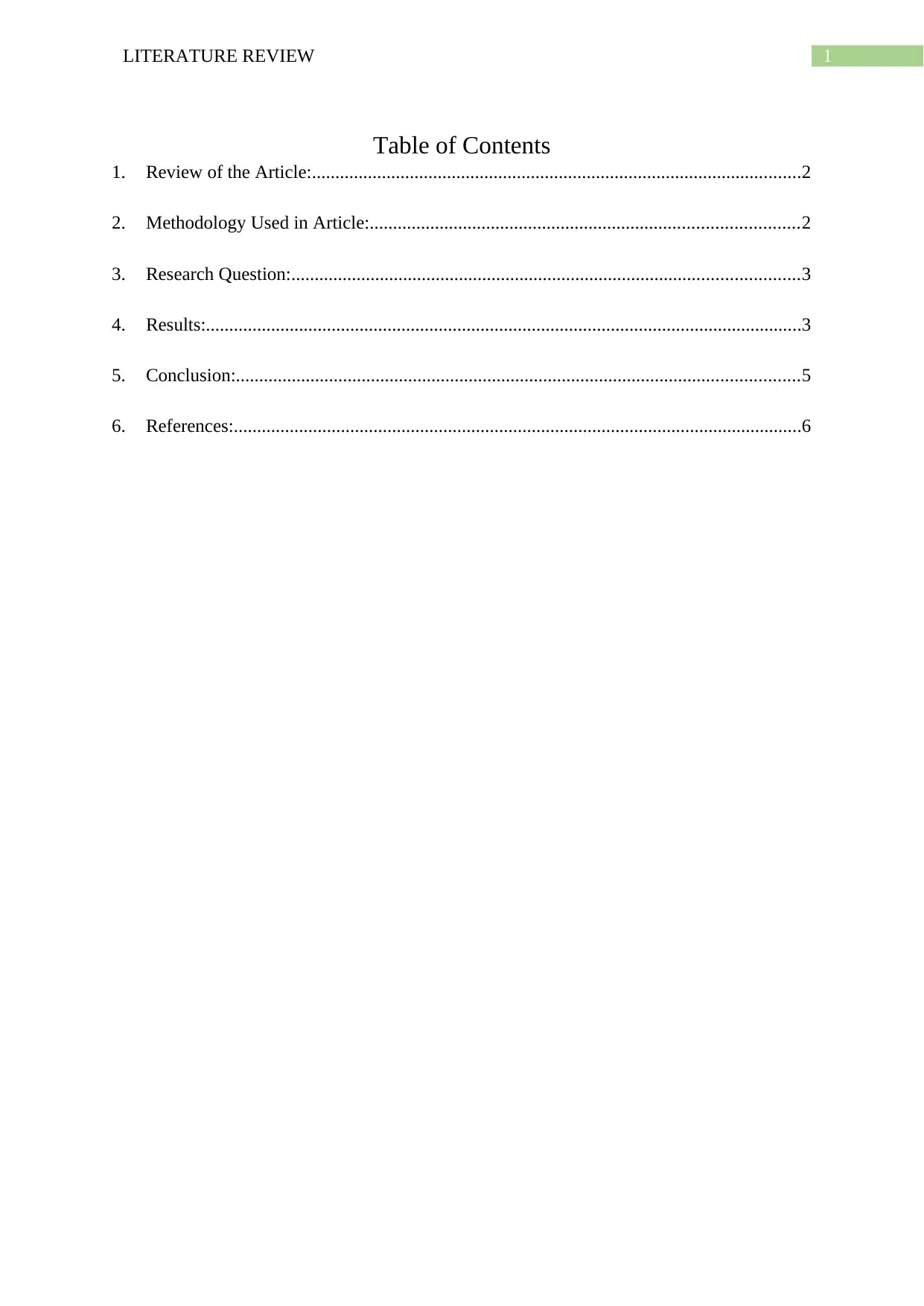
1LITERATURE REVIEW
Table of Contents
1. Review of the Article:.........................................................................................................2
2. Methodology Used in Article:............................................................................................2
3. Research Question:.............................................................................................................3
4. Results:................................................................................................................................3
5. Conclusion:.........................................................................................................................5
6. References:..........................................................................................................................6
Table of Contents
1. Review of the Article:.........................................................................................................2
2. Methodology Used in Article:............................................................................................2
3. Research Question:.............................................................................................................3
4. Results:................................................................................................................................3
5. Conclusion:.........................................................................................................................5
6. References:..........................................................................................................................6
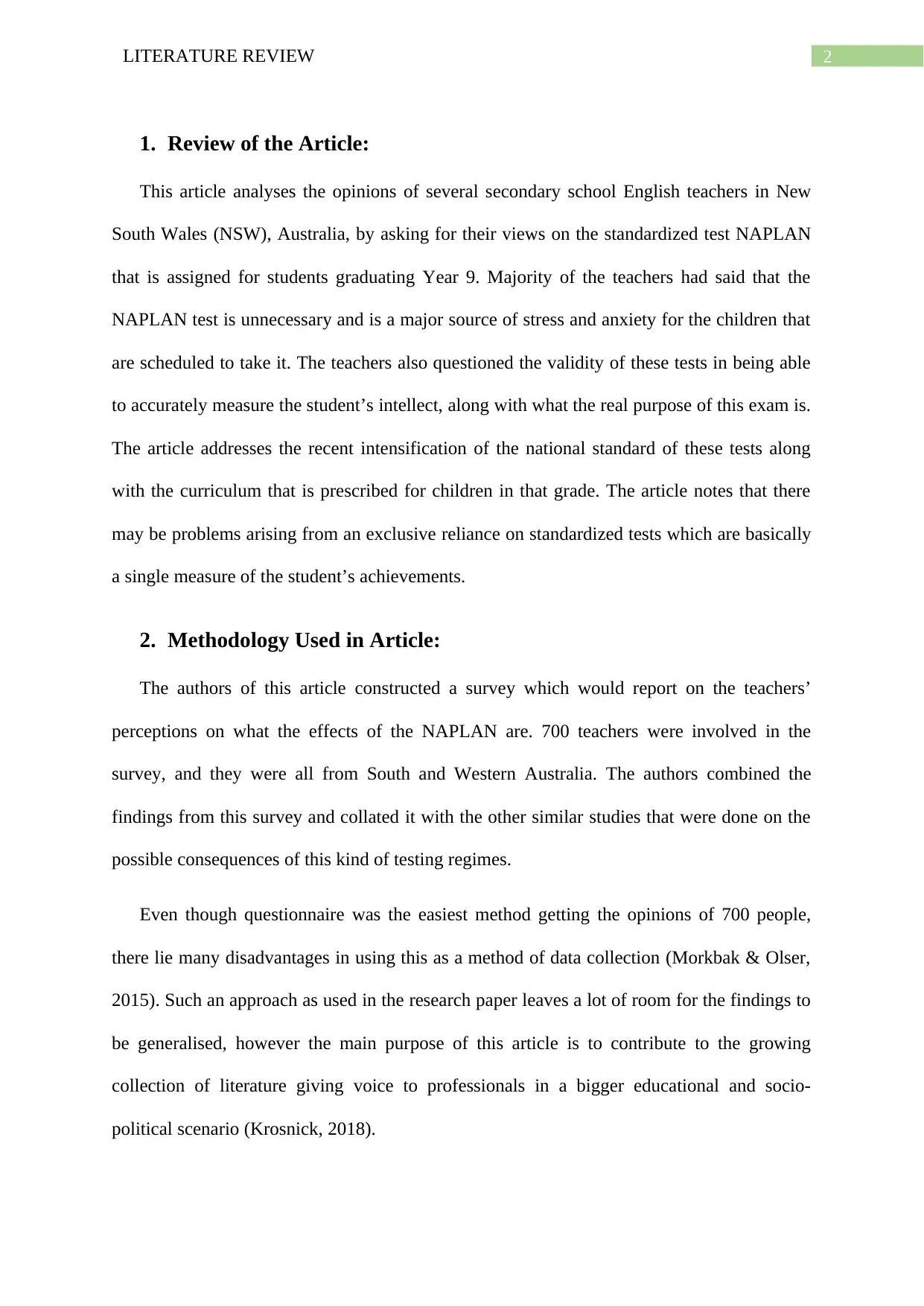
2LITERATURE REVIEW
1. Review of the Article:
This article analyses the opinions of several secondary school English teachers in New
South Wales (NSW), Australia, by asking for their views on the standardized test NAPLAN
that is assigned for students graduating Year 9. Majority of the teachers had said that the
NAPLAN test is unnecessary and is a major source of stress and anxiety for the children that
are scheduled to take it. The teachers also questioned the validity of these tests in being able
to accurately measure the student’s intellect, along with what the real purpose of this exam is.
The article addresses the recent intensification of the national standard of these tests along
with the curriculum that is prescribed for children in that grade. The article notes that there
may be problems arising from an exclusive reliance on standardized tests which are basically
a single measure of the student’s achievements.
2. Methodology Used in Article:
The authors of this article constructed a survey which would report on the teachers’
perceptions on what the effects of the NAPLAN are. 700 teachers were involved in the
survey, and they were all from South and Western Australia. The authors combined the
findings from this survey and collated it with the other similar studies that were done on the
possible consequences of this kind of testing regimes.
Even though questionnaire was the easiest method getting the opinions of 700 people,
there lie many disadvantages in using this as a method of data collection (Morkbak & Olser,
2015). Such an approach as used in the research paper leaves a lot of room for the findings to
be generalised, however the main purpose of this article is to contribute to the growing
collection of literature giving voice to professionals in a bigger educational and socio-
political scenario (Krosnick, 2018).
1. Review of the Article:
This article analyses the opinions of several secondary school English teachers in New
South Wales (NSW), Australia, by asking for their views on the standardized test NAPLAN
that is assigned for students graduating Year 9. Majority of the teachers had said that the
NAPLAN test is unnecessary and is a major source of stress and anxiety for the children that
are scheduled to take it. The teachers also questioned the validity of these tests in being able
to accurately measure the student’s intellect, along with what the real purpose of this exam is.
The article addresses the recent intensification of the national standard of these tests along
with the curriculum that is prescribed for children in that grade. The article notes that there
may be problems arising from an exclusive reliance on standardized tests which are basically
a single measure of the student’s achievements.
2. Methodology Used in Article:
The authors of this article constructed a survey which would report on the teachers’
perceptions on what the effects of the NAPLAN are. 700 teachers were involved in the
survey, and they were all from South and Western Australia. The authors combined the
findings from this survey and collated it with the other similar studies that were done on the
possible consequences of this kind of testing regimes.
Even though questionnaire was the easiest method getting the opinions of 700 people,
there lie many disadvantages in using this as a method of data collection (Morkbak & Olser,
2015). Such an approach as used in the research paper leaves a lot of room for the findings to
be generalised, however the main purpose of this article is to contribute to the growing
collection of literature giving voice to professionals in a bigger educational and socio-
political scenario (Krosnick, 2018).
⊘ This is a preview!⊘
Do you want full access?
Subscribe today to unlock all pages.

Trusted by 1+ million students worldwide
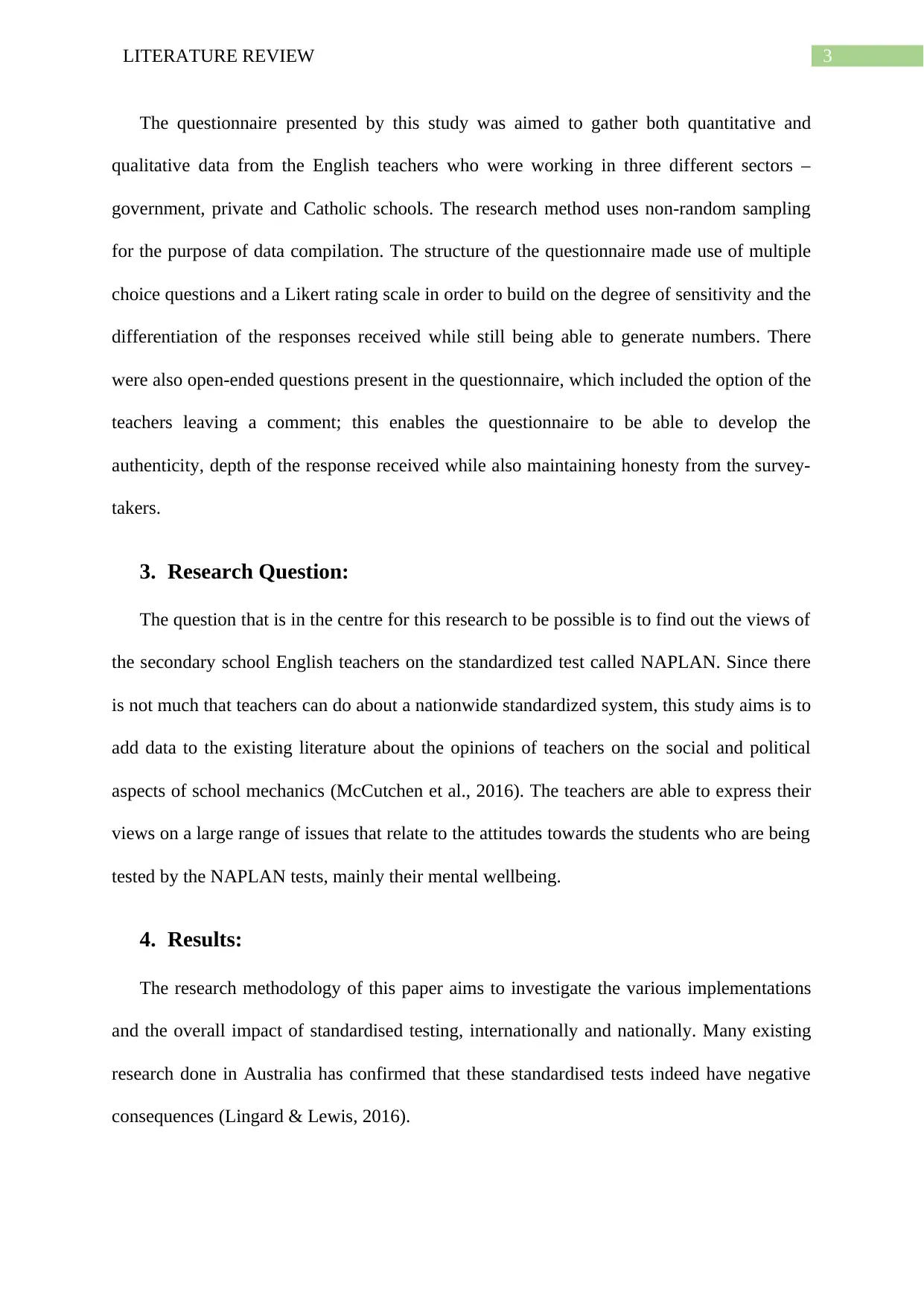
3LITERATURE REVIEW
The questionnaire presented by this study was aimed to gather both quantitative and
qualitative data from the English teachers who were working in three different sectors –
government, private and Catholic schools. The research method uses non-random sampling
for the purpose of data compilation. The structure of the questionnaire made use of multiple
choice questions and a Likert rating scale in order to build on the degree of sensitivity and the
differentiation of the responses received while still being able to generate numbers. There
were also open-ended questions present in the questionnaire, which included the option of the
teachers leaving a comment; this enables the questionnaire to be able to develop the
authenticity, depth of the response received while also maintaining honesty from the survey-
takers.
3. Research Question:
The question that is in the centre for this research to be possible is to find out the views of
the secondary school English teachers on the standardized test called NAPLAN. Since there
is not much that teachers can do about a nationwide standardized system, this study aims is to
add data to the existing literature about the opinions of teachers on the social and political
aspects of school mechanics (McCutchen et al., 2016). The teachers are able to express their
views on a large range of issues that relate to the attitudes towards the students who are being
tested by the NAPLAN tests, mainly their mental wellbeing.
4. Results:
The research methodology of this paper aims to investigate the various implementations
and the overall impact of standardised testing, internationally and nationally. Many existing
research done in Australia has confirmed that these standardised tests indeed have negative
consequences (Lingard & Lewis, 2016).
The questionnaire presented by this study was aimed to gather both quantitative and
qualitative data from the English teachers who were working in three different sectors –
government, private and Catholic schools. The research method uses non-random sampling
for the purpose of data compilation. The structure of the questionnaire made use of multiple
choice questions and a Likert rating scale in order to build on the degree of sensitivity and the
differentiation of the responses received while still being able to generate numbers. There
were also open-ended questions present in the questionnaire, which included the option of the
teachers leaving a comment; this enables the questionnaire to be able to develop the
authenticity, depth of the response received while also maintaining honesty from the survey-
takers.
3. Research Question:
The question that is in the centre for this research to be possible is to find out the views of
the secondary school English teachers on the standardized test called NAPLAN. Since there
is not much that teachers can do about a nationwide standardized system, this study aims is to
add data to the existing literature about the opinions of teachers on the social and political
aspects of school mechanics (McCutchen et al., 2016). The teachers are able to express their
views on a large range of issues that relate to the attitudes towards the students who are being
tested by the NAPLAN tests, mainly their mental wellbeing.
4. Results:
The research methodology of this paper aims to investigate the various implementations
and the overall impact of standardised testing, internationally and nationally. Many existing
research done in Australia has confirmed that these standardised tests indeed have negative
consequences (Lingard & Lewis, 2016).
Paraphrase This Document
Need a fresh take? Get an instant paraphrase of this document with our AI Paraphraser

4LITERATURE REVIEW
A great majority of the participants had expressed strong antipathy towards NAPLAN
being able to correctly analyse the literacy skills of their students. Many of the teachers have
said that they are better judges of the intellect level of their student and can better judge their
standards, as compared to the results given by the NAPLAN tests. Another aspect of the
questionnaire had asked if the materials required for the student to do well in the NAPLAN is
influencing the content being taught in the schools. It is interesting to note that all the
teachers are aware of the official statement that tells them to not carry out their teachings
according to the test (Rose, 2016), but every year they are finding themselves teaching tasks
that is required to pass the standardized test.
Another question from the questionnaire asks the teachers if they believe that the
NAPLAN tests accurately measures the student’s achievement. Almost 76% of the teachers
strongly disagreed to this statement and one of the teacher has added that the standardised test
is able to evaluate a very narrow aspect of the student’s capabilities. The main problem that
the teachers have with these tests is that in the environment of the 21st century style of
learning, antiquated tested of mere grammar and language will not be able to measure a
student’s capability and drive to do something that they are inherently good at (Knoester &
Au, 2017). Many teachers have also said that these standardized tests do not and cannot fully
prepare a student for future employment and further studies, more than their own teachers
will be able to.
A very interesting aspect from the results to note is that even though there has been an
extensive amount of financial resources allocated by the government that is directed towards
deriving the material for these tests, the teachers are noting that the overall level of literacy of
a student’s achievements has still not been enhanced.
A great majority of the participants had expressed strong antipathy towards NAPLAN
being able to correctly analyse the literacy skills of their students. Many of the teachers have
said that they are better judges of the intellect level of their student and can better judge their
standards, as compared to the results given by the NAPLAN tests. Another aspect of the
questionnaire had asked if the materials required for the student to do well in the NAPLAN is
influencing the content being taught in the schools. It is interesting to note that all the
teachers are aware of the official statement that tells them to not carry out their teachings
according to the test (Rose, 2016), but every year they are finding themselves teaching tasks
that is required to pass the standardized test.
Another question from the questionnaire asks the teachers if they believe that the
NAPLAN tests accurately measures the student’s achievement. Almost 76% of the teachers
strongly disagreed to this statement and one of the teacher has added that the standardised test
is able to evaluate a very narrow aspect of the student’s capabilities. The main problem that
the teachers have with these tests is that in the environment of the 21st century style of
learning, antiquated tested of mere grammar and language will not be able to measure a
student’s capability and drive to do something that they are inherently good at (Knoester &
Au, 2017). Many teachers have also said that these standardized tests do not and cannot fully
prepare a student for future employment and further studies, more than their own teachers
will be able to.
A very interesting aspect from the results to note is that even though there has been an
extensive amount of financial resources allocated by the government that is directed towards
deriving the material for these tests, the teachers are noting that the overall level of literacy of
a student’s achievements has still not been enhanced.
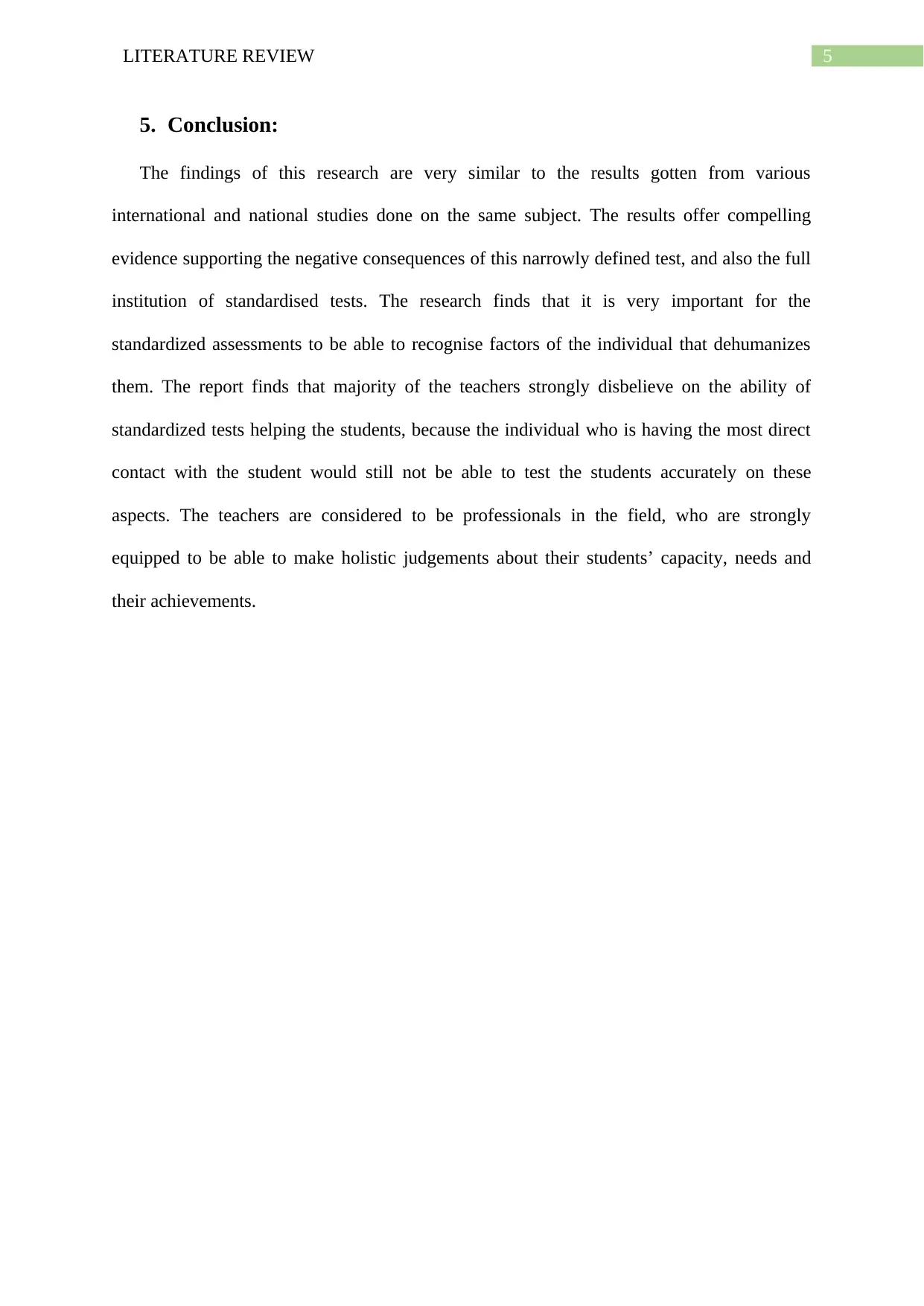
5LITERATURE REVIEW
5. Conclusion:
The findings of this research are very similar to the results gotten from various
international and national studies done on the same subject. The results offer compelling
evidence supporting the negative consequences of this narrowly defined test, and also the full
institution of standardised tests. The research finds that it is very important for the
standardized assessments to be able to recognise factors of the individual that dehumanizes
them. The report finds that majority of the teachers strongly disbelieve on the ability of
standardized tests helping the students, because the individual who is having the most direct
contact with the student would still not be able to test the students accurately on these
aspects. The teachers are considered to be professionals in the field, who are strongly
equipped to be able to make holistic judgements about their students’ capacity, needs and
their achievements.
5. Conclusion:
The findings of this research are very similar to the results gotten from various
international and national studies done on the same subject. The results offer compelling
evidence supporting the negative consequences of this narrowly defined test, and also the full
institution of standardised tests. The research finds that it is very important for the
standardized assessments to be able to recognise factors of the individual that dehumanizes
them. The report finds that majority of the teachers strongly disbelieve on the ability of
standardized tests helping the students, because the individual who is having the most direct
contact with the student would still not be able to test the students accurately on these
aspects. The teachers are considered to be professionals in the field, who are strongly
equipped to be able to make holistic judgements about their students’ capacity, needs and
their achievements.
⊘ This is a preview!⊘
Do you want full access?
Subscribe today to unlock all pages.

Trusted by 1+ million students worldwide
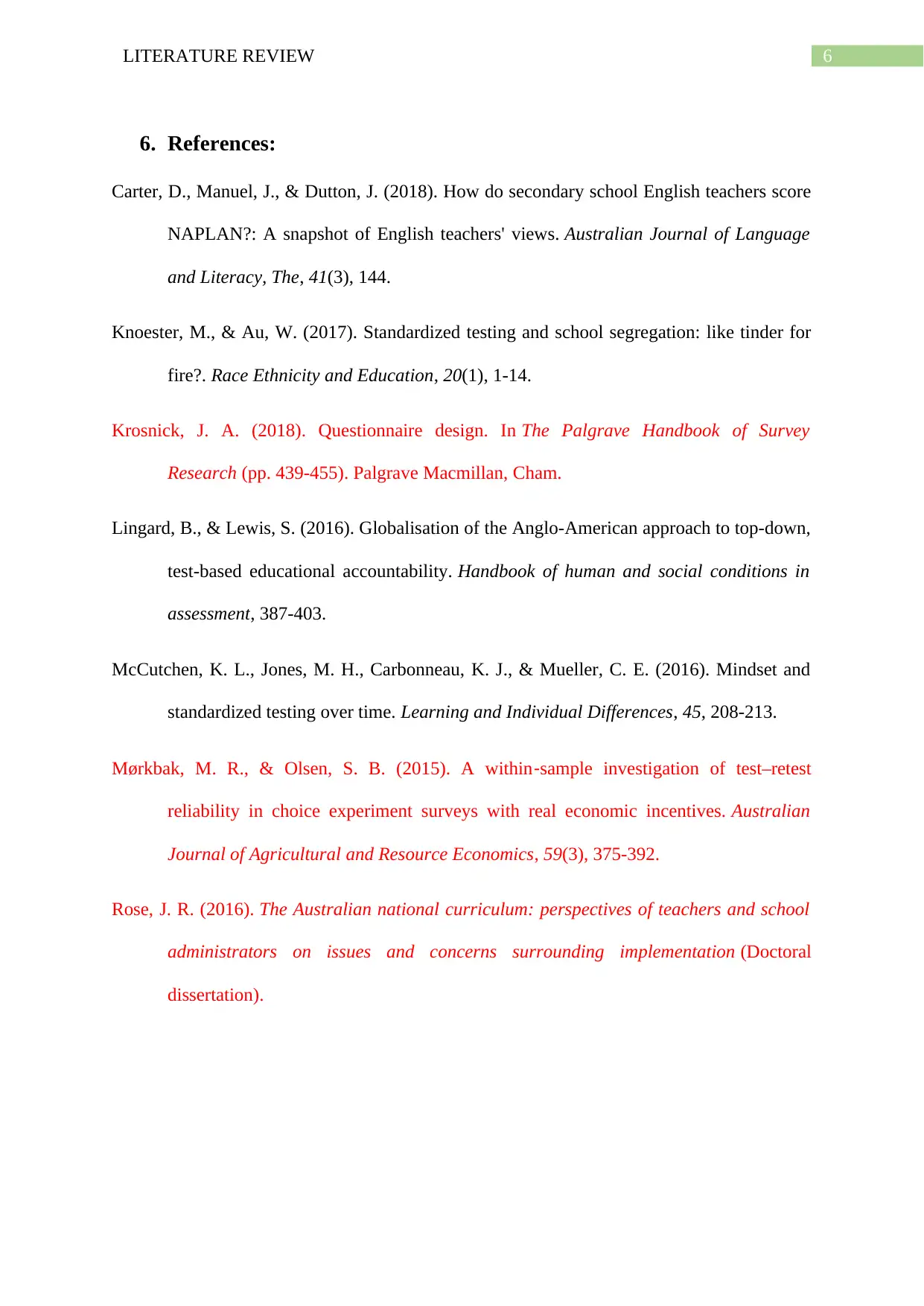
6LITERATURE REVIEW
6. References:
Carter, D., Manuel, J., & Dutton, J. (2018). How do secondary school English teachers score
NAPLAN?: A snapshot of English teachers' views. Australian Journal of Language
and Literacy, The, 41(3), 144.
Knoester, M., & Au, W. (2017). Standardized testing and school segregation: like tinder for
fire?. Race Ethnicity and Education, 20(1), 1-14.
Krosnick, J. A. (2018). Questionnaire design. In The Palgrave Handbook of Survey
Research (pp. 439-455). Palgrave Macmillan, Cham.
Lingard, B., & Lewis, S. (2016). Globalisation of the Anglo-American approach to top-down,
test-based educational accountability. Handbook of human and social conditions in
assessment, 387-403.
McCutchen, K. L., Jones, M. H., Carbonneau, K. J., & Mueller, C. E. (2016). Mindset and
standardized testing over time. Learning and Individual Differences, 45, 208-213.
Mørkbak, M. R., & Olsen, S. B. (2015). A within‐sample investigation of test–retest
reliability in choice experiment surveys with real economic incentives. Australian
Journal of Agricultural and Resource Economics, 59(3), 375-392.
Rose, J. R. (2016). The Australian national curriculum: perspectives of teachers and school
administrators on issues and concerns surrounding implementation (Doctoral
dissertation).
6. References:
Carter, D., Manuel, J., & Dutton, J. (2018). How do secondary school English teachers score
NAPLAN?: A snapshot of English teachers' views. Australian Journal of Language
and Literacy, The, 41(3), 144.
Knoester, M., & Au, W. (2017). Standardized testing and school segregation: like tinder for
fire?. Race Ethnicity and Education, 20(1), 1-14.
Krosnick, J. A. (2018). Questionnaire design. In The Palgrave Handbook of Survey
Research (pp. 439-455). Palgrave Macmillan, Cham.
Lingard, B., & Lewis, S. (2016). Globalisation of the Anglo-American approach to top-down,
test-based educational accountability. Handbook of human and social conditions in
assessment, 387-403.
McCutchen, K. L., Jones, M. H., Carbonneau, K. J., & Mueller, C. E. (2016). Mindset and
standardized testing over time. Learning and Individual Differences, 45, 208-213.
Mørkbak, M. R., & Olsen, S. B. (2015). A within‐sample investigation of test–retest
reliability in choice experiment surveys with real economic incentives. Australian
Journal of Agricultural and Resource Economics, 59(3), 375-392.
Rose, J. R. (2016). The Australian national curriculum: perspectives of teachers and school
administrators on issues and concerns surrounding implementation (Doctoral
dissertation).
1 out of 7
Related Documents
Your All-in-One AI-Powered Toolkit for Academic Success.
+13062052269
info@desklib.com
Available 24*7 on WhatsApp / Email
![[object Object]](/_next/static/media/star-bottom.7253800d.svg)
Unlock your academic potential
Copyright © 2020–2025 A2Z Services. All Rights Reserved. Developed and managed by ZUCOL.





